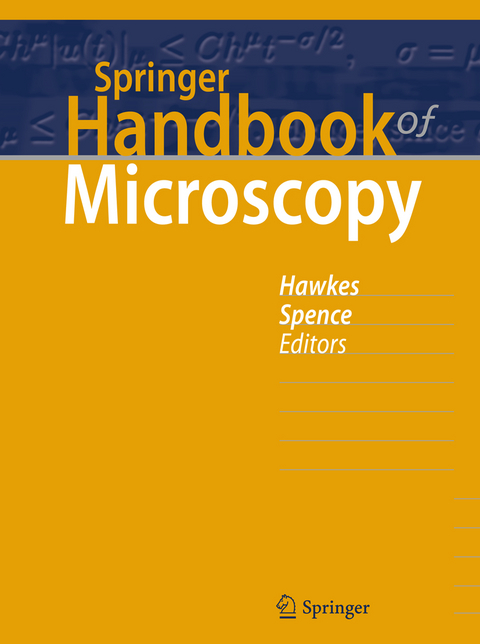
Springer Handbook of Microscopy
Springer International Publishing (Verlag)
978-3-030-00068-4 (ISBN)
This book features reviews by leading experts on the methods and applications of modern forms of microscopy. The recent awards of Nobel Prizes awarded for super-resolution optical microscopy and cryo-electron microscopy have demonstrated the rich scientific opportunities for research in novel microscopies. Earlier Nobel Prizes for electron microscopy (the instrument itself and applications to biology), scanning probe microscopy and holography are a reminder of the central role of microscopy in modern science, from the study of nanostructures in materials science, physics and chemistry to structural biology.
Separate chapters are devoted to confocal, fluorescent and related novel optical microscopies, coherent diffractive imaging, scanning probe microscopy, transmission electron microscopy in all its modes from aberration corrected and analytical to in-situ and time-resolved, low energy electron microscopy, photoelectron microscopy, cryo-electron microscopy in biology, and alsoion microscopy.
In addition to serving as an essential reference for researchers and teachers in the fields such as materials science, condensed matter physics, solid-state chemistry, structural biology and the molecular sciences generally, the Springer Handbook of Microscopy is a unified, coherent and pedagogically attractive text for advanced students who need an authoritative yet accessible guide to the science and practice of microscopy.
Peter Hawkes received his Ph.D. in Physics from the University of Cambridge in 1963, after which he continued his research on electron optics, and in particular on aberration theory and image processing, in the Cavendish Laboratory until 1975. He then moved to the CNRS Laboratory of Electron Optics in Toulouse, of which he was Director in 1987, and published extensively on electron lens aberrations and theoretical aspects of image processing. In 2002, he was awarded the status of Emeritus CNRS Director of Research. He has been President of the French Microscopy Society and was Founder-President of the European Microscopy Society. John Spence FRS received his Ph.D. in Physics from Melbourne in 1973 followed by post-doctoral work in Oxford, UK. He joined John Cowley's electron microscopy group in Physics at Arizona State University in 1977 where he is Regent's Professor of Physics. His group has undertaken research in diffraction physics and novel microscopies with applications in condensed matter physics, materials science and structural biology. He is currently Director of Science for an NSF consortium of seven US universities in the development and application of free-electron X-ray lasers to biology.
Part A: Electron and Ion Microscopy.- Kirkland et al.: Atomic Resolution Transmission Electron Microscopy.- Nellist: Scanning Transmission Electron Microscopy.- Ross & Minor: In situ Transmission Electron Microscopy.- Plitzko & Baumeister: Crytoelectron TEM.- Erdmann et al: Scanning Electron Microscopy.- Thiel: Variable Pressure Scanning Electron Microscopy.- Botton, Pradhudev: Analytical Electron Microscopy.- Campbell et al: High-Speed Electron Microscopy.- Bauer: LEEM, SPLEEM and SPELEEM.- Feng & Scholl: Photoemission Electron Microscopy.- Tromp: Spectroscopy with the Low Energy Electron Microscope.- Van Aert: Model-Based Electron Microscopy.- Hawkes & Krivanek: Aberration Correctors, Monochromators, Spectrometer.- Hlawacek: Ion Microscopy.-Kelly: Atom-Probe Tomography.- Part B: Holography, Ptychography and Diffraction.- Dunin-Borkowski et al.: Electron Holography.-Rodenburg & Maiden: Ptychography.- Zuo: Electron Nanodiffraction.- Musumeci & Li: High-Energy Time-Resolved Electron Diffraction.- Spence: Diffractive Imaging of Single Particles.- Part C: Photon-based Microscopy.- Diaspro et al: Fluorescence Microscopy.- Sahl et al.: Far-Field Fluorescence Microscopy.- Jacobson et al: Zone-Plate X-Ray Microscopy.- Lin et al: Microcomputed Tomography.- Part D: Applied Microscopy.- Huey et al: Scanning Probe Microscopy in Materials Science.- Leary & Midgeley: Electron Tomography in Materials Science.- Sutter: Scanning Tunneling Microscopy in Surface Science.- Hamidian et al: Visualizing electronic quantum matter.- Ma et al (Terasaki): Microscopy of Nanoporous Crystals.- Wen: Biomedical X-Ray Phase-Contrast Imaging and Tomography.- Amrein & Stamov: Atomic Force Microscopy in the Life Sciences.- Jones: Microscopy in Forensic Sciences.
"This book highlights the unity of electron microscopy, X-ray microscopy and optical microscopy ... . This handbook is a recommended source of information on microscopy theory, instrumentation, applications, limitations, trade-offs and pitfalls. ... The contributors have produced outstanding chapters, which should be noted for their comprehensive analysis of the theory and the instruments, their critical selection of figures, and their selection of key references." (Barry R. Masters, Optics & Photonics News, April 9, 2020)
| Erscheinungsdatum | 05.07.2019 |
|---|---|
| Reihe/Serie | Springer Handbooks |
| Zusatzinfo | XXXII, 1543 p. 1140 illus. in color. |
| Verlagsort | Cham |
| Sprache | englisch |
| Maße | 193 x 260 mm |
| Themenwelt | Naturwissenschaften ► Chemie ► Analytische Chemie |
| Naturwissenschaften ► Physik / Astronomie ► Angewandte Physik | |
| Technik ► Maschinenbau | |
| Schlagworte | aberration correctons, monochromators, spectromete • aberration correctons, monochromators, spectrometers • atomic force microscopy, AFM • Biological Microscopy • cryo-electron micvroscopy in biology • Holography • low energy electron microscopy, LEEM • ptychography • scanning electron microscopy, SEM • scanning transmission electron microscope, STEM • super.resolution fluorescence microscopy • Super-resolution fluorescence microscopy • transmission electron microscopy, TEM |
| ISBN-10 | 3-030-00068-0 / 3030000680 |
| ISBN-13 | 978-3-030-00068-4 / 9783030000684 |
| Zustand | Neuware |
| Haben Sie eine Frage zum Produkt? |
aus dem Bereich


